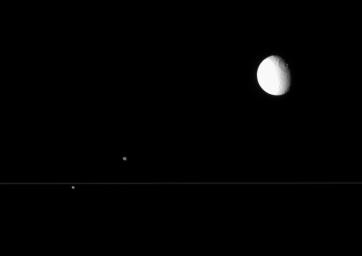
|
Cassini Scores a Triple
- Click the image above for a larger view
- Full-Res JPEG (809 x 572) (7.9 kB)
- Full-Res TIFF (809 x 572) (463.4 kB)
Caption:
The Cassini spacecraft's views from edge-on with the rings are perfect for capturing multiple Saturnian moons grouped closely.
Here Tethys (1,071 kilometers, or 665 miles across), with its enormous crater Odysseus, is partly overexposed near upper right. At left, Epimetheus (116 kilometers, or 72 miles across) hovers above the rings, while Pandora (84 kilometers, or 52 miles across) hangs below.
The image was taken in visible light with the Cassini spacecraft narrow-angle camera on July 2, 2007 at a distance of approximately 2.2 million kilometers (1.4 million miles) from Saturn. Image scale is 12 kilometers (7 miles) per pixel on Tethys, 13 kilometers (8 miles) per pixel on Pandora, and 14 kilometers (9 miles) per pixel on Epimetheus.
Background Info:
The Cassini-Huygens mission is a cooperative project of NASA, the European Space Agency and the Italian Space Agency. The Jet Propulsion Laboratory, a division of the California Institute of Technology in Pasadena, manages the mission for NASA's Science Mission Directorate, Washington, D.C. The Cassini orbiter and its two onboard cameras were designed, developed and assembled at JPL. The imaging operations center is based at the Space Science Institute in Boulder, Colo.
For more information about the Cassini-Huygens mission visit http://saturn.jpl.nasa.gov/home/index.cfm . The Cassini imaging team homepage is at http://ciclops.org .
Cataloging Keywords:
| Name | Value | Additional Values |
|---|---|---|
| Target | Tethys | Epimetheus, Pandora, Saturn |
| System | Saturn | |
| Target Type | Satellite | Planet |
| Mission | Cassini-Huygens | |
| Instrument Host | Cassini Orbiter | |
| Host Type | Orbiter | |
| Instrument | Imaging Science Subsystem (ISS) | |
| Detector | Narrow Angle Camera | |
| Extra Keywords | Crater, Grayscale, Visual | |
| Acquisition Date | ||
| Release Date | 2007-08-17 | |
| Date in Caption | 2007-07-02 | |
| Image Credit | NASA/JPL/Space Science Institute | |
| Source | photojournal.jpl.nasa.gov/catalog/PIA09008 | |
| Identifier | PIA09008 | |
